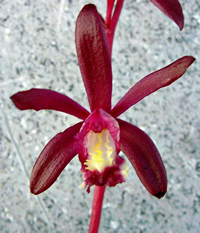Chiricahua Mountains
 The Southwestern Research Station operated by the American Museum of Natural History sits at the eastern base of the mountain range. Photo from research.amnh.org.
The Southwestern Research Station operated by the American Museum of Natural History sits at the eastern base of the mountain range. Photo from research.amnh.org.
 The Chiricahua National Monument is famous for its wonderland of rock spires. Photo by Charlie McDonald.
The Chiricahua National Monument is famous for its wonderland of rock spires. Photo by Charlie McDonald.
 Engelmann spruce (Picea engelmanii) reaches its southernmost limit in North America in the Chiricahua Mountains. Photo by Max Licher at swbiodiversity.org.
Engelmann spruce (Picea engelmanii) reaches its southernmost limit in North America in the Chiricahua Mountains. Photo by Max Licher at swbiodiversity.org.
 Lemon lily (Lilium parryi) is the only large-flowered yellow lily in Arizona. It is a rare plant found in three Sky Island mountain ranges, southern California, and one mountain range in Sonora, Mexico. Photo by Jordan Zylstra, U.S. Forest Service.
Lemon lily (Lilium parryi) is the only large-flowered yellow lily in Arizona. It is a rare plant found in three Sky Island mountain ranges, southern California, and one mountain range in Sonora, Mexico. Photo by Jordan Zylstra, U.S. Forest Service.
 Texas crested coralroot (Hexalectris warnockii) is a rare orchid that grows in oak-pine forests. Its occurrence is very sporadic. It grows in three Sky Island mountain ranges, scattered locations in Texas, and in Mexico. Photo by Michael Wilson at swbiodiversity.org.
Texas crested coralroot (Hexalectris warnockii) is a rare orchid that grows in oak-pine forests. Its occurrence is very sporadic. It grows in three Sky Island mountain ranges, scattered locations in Texas, and in Mexico. Photo by Michael Wilson at swbiodiversity.org.
High Point: Chiricahua Peak, 9,759 feet
Elevation Change from Base: 5,259 feet
Vegetation at Highest Elevations: Douglas-fir-mixed conifer forest; pine forest
The Chiricahua Mountains are the largest of Arizona’s Sky Island mountain ranges and the second highest. The main crest of the mountain range resembles rolling hills atop a narrow high plateau rather than distinct mountain peaks. This relatively flat area is bounded on the east and west by steep slopes and sharply dissected canyons. Engelmann spruce (Picea engelmanii)reaches its southernmost limit in North America in this mountain range. The vegetation at upper elevations is dominated by ponderosa pine, Douglas-fir, and white fir, with the ponderosa pine evenly distributed and the other two conifers confined mostly to north-facing slopes. Small dense stands of Engelmann spruce are found on several north-facing slopes.
Special Places:
- Chiricahua National Monument: This National Monument features a wonderland of rock spires eroded from layers of ash deposited by the Turkey Creek Volcanic eruption 27 million years ago.
- Chiricahua Wilderness: The Chiricahua Wilderness is home to a fascinating diversity of both plant and animal life, as well as some of the Southwest’s most spectacular geology. This 87,700-acre wilderness covers much of the upper slopes and inner canyons of the mountain range.
- Southwestern Research Station: The Southwestern Research Station is a year-round field station owned and operated by the American Museum of Natural History. Since 1955, it has served biologists, geologists, and anthropologists interested in studying the diverse environments and biotas of the Chiricahua Mountains.
Special Plants:
- Arabis tricornuta
- Asclepias lemmonii
- Aster potosinus
- Astragalus cobrensis var. maguirei
- Castilleja nervata
- Erigeron kuschei
- Gentianella wislizenii
- Hexalectris warnockii
- Hieracium pringlei
- Hieracium rusbyi
- Lilium parryi
- Limosella pubiflora
- Lupinus huachucanus
- Lupinus lemmonii
- Malaxis porphyria
- Packera neomexicana var. toumeyi
- Pectis imberbis
- Potentilla rhyolitica var. rhyolitica
- Psilactis gentry
- Senecio huachucanus
- Tragia laciniata
- Viola umbraticola
Further Reading:


